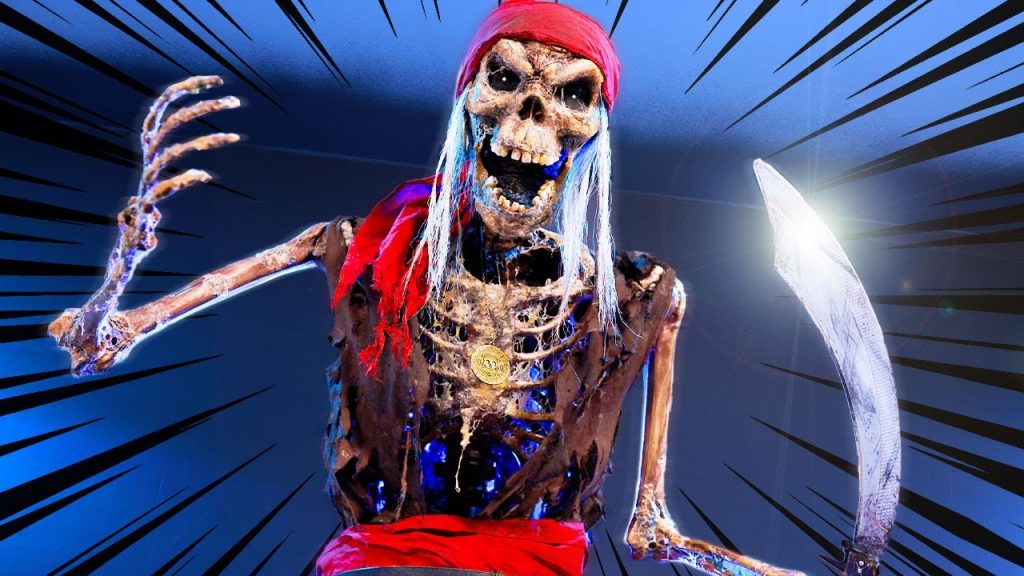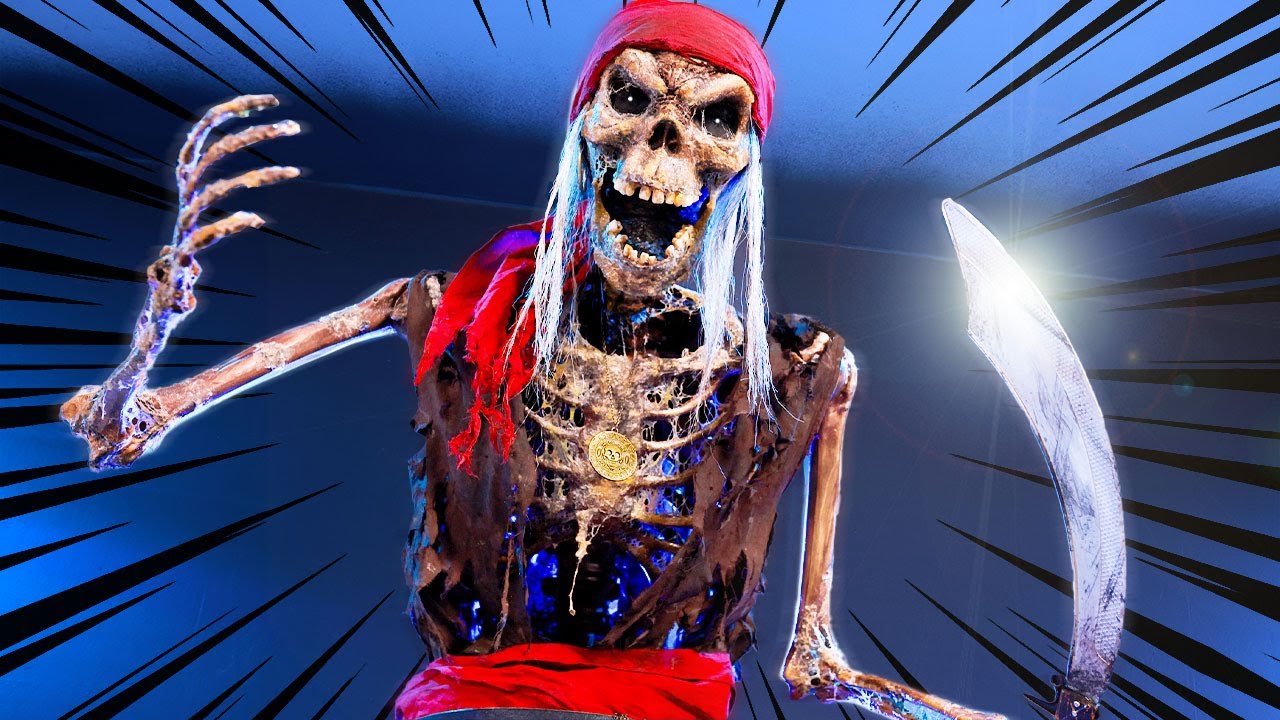You’re about to embark on a DIY journey to create a skeleton pirate animatronic for Halloween with Jaimie and Jay of Wicked Makers. This tutorial will guide you through the process of building a swaying animatronic mechanism, corpsing a skeleton, aging and weathering clothes, and painting the skeleton to perfection. From ripping off the head of a plastic skeleton to adding rotting flesh and tattered clothes, this easy DIY project is a great way to bring your own Halloween animatronic to life.
With the help of simple tools like a saw and drill, you’ll transform a plastic skeleton into a drunken pirate animatronic with a swaying motion. Follow along as the tutorial covers the step-by-step process of building the animatronic mechanism using PVC pipe, constructing a base with a wiper motor for movement, and detailing the painting and weathering of clothes. Get ready to turn heads with this spooky Halloween project and have the chance to win the animatronic by counting how many times the skeleton pops up in the video and suggesting a name.
Materials Used
For this DIY project, you will need the following materials:
Animatronic mechanism
The animatronic mechanism is the heart of this project, providing motion to the skeleton. It will help the pirate skeleton come to life with swaying movements.
Aluminum bars
Aluminum bars are essential for providing structural support and stability to the animatronic mechanism. They help in connecting different components together securely.
PVC connectors
PVC connectors play a crucial role in assembling the animatronic mechanism. They enable flexible movements and ensure smooth transitions between different parts.
Nylon bushings
Nylon bushings are essential for reducing friction and allowing smooth movements within the mechanism. They enhance the durability and longevity of the animatronic setup.
Washers
Washers help in distributing pressure evenly and preventing damage to the components. They are essential for maintaining the stability and functionality of the mechanism.
Bolts
Bolts are used for securing different parts together and ensuring that the animatronic mechanism stays intact. They provide strength and stability to the structure.
Lock nuts
Lock nuts play a critical role in preventing bolts from loosening over time. They provide additional security and stability, ensuring that the mechanism functions smoothly.
Plywood
Plywood is used as a sturdy base for the animatronic setup. It provides a solid foundation for attaching various components and ensures the stability of the entire mechanism.
Plastic lunchbox
The plastic lunchbox serves as a protective casing for the motor and electronic components. It helps in keeping them safe from environmental factors such as water and dust.
Zombie pirate skeleton
The zombie pirate skeleton is the main attraction of the project. It serves as the canvas for creating a terrifying animatronic character for Halloween.
Pirate clothes
Pirate clothes are used to dress up the skeleton and give it a realistic appearance. They add to the spooky and eerie vibe of the animatronic pirate.
Tools Used
To bring this DIY project to life, you will need the following tools:
Saw
A saw is essential for cutting and shaping various materials, such as wood and PVC pipes. It helps in creating precise and clean cuts for assembling the animatronic mechanism.
Drill
A drill is necessary for creating holes in different components to attach bolts, nuts, and connectors. It helps in securing the parts together and ensures a sturdy construction.
Tutorial Overview
The tutorial covers various aspects of creating a spooky animatronic pirate for Halloween. Here’s a breakdown of the key steps involved:
Building a swaying animatronic mechanism
The first step involves constructing a swaying mechanism using PVC pipes, nylon bushings, and aluminum bars. This mechanism will provide the skeleton with realistic movement and add dynamism to the animatronic character.
Corpsing a skeleton
Corpsing refers to the process of giving the skeleton a decayed and rotting appearance. Using cotton, latex, and contact cement, you can transform the plastic skeleton into a terrifying zombie pirate ready to haunt your Halloween decor.
Aging and weathering clothes
To enhance the realism of the skeleton, you can age and weather the pirate clothes obtained from a thrift store. This step adds authenticity to the character and completes the spooky look of the animatronic pirate.
Painting the skeleton
The final touch involves painting the skeleton to bring out its ghoulish features. By adding details like weathering effects, cracks, and discoloration, you can create a bone-chilling appearance for your animatronic pirate.

DIY Halloween Project
This easy DIY project offers an exciting opportunity to create your own animatronic pirate for Halloween. The step-by-step tutorial guides you through the process of building a swaying mechanism, corpsing a skeleton, and painting the character to perfection.
For more Halloween DIY inspiration and ideas, check out the Wicked Makers’ channel. Explore a wide range of DIY props and decorations to make your Halloween celebrations truly spooktacular!
Transformation Process
To start, you will need a plastic skeleton as the base for your animatronic pirate. By removing the head, breaking bones, and building a PVC mechanism with a wiper motor, you can infuse life into the skeleton. Dressing it in pirate clothes and giving it a rotting flesh appearance will complete the transformation.
Step-by-Step Guide
The detailed step-by-step guide takes you through the entire Halloween DIY process. From painting and weathering clothes to adding hair and creating a realistic finish, each step is crucial in bringing the animatronic pirate to life.
Assembly Process
Once all the components are prepared, the assembly process begins by setting up the power supply and installing the prop controller. Adding a motion sensor further enhances the interactive nature of the animatronic pirate, making it a captivating centerpiece for Halloween.
Improvements Made
Several improvements are implemented to enhance the functionality and appearance of the animatronic pirate. Modifications are made to the skeleton to conceal the mechanism and improve its movement, ensuring a more seamless and immersive experience.
Contest Details
As part of the Halloween fun, there is an opportunity for viewers to win the animatronic pirate. By counting how many times the skeleton pops up in the video and suggesting a fitting name for the character, participants can enter the contest and potentially bring this spooky creation home.
Demonstration
The culmination of the project includes a demonstration of the complete animatronic pirate costume. The showcase highlights the intricate movements, design details, and overall impact of the animatronic character, setting the stage for a thrilling Halloween display.




